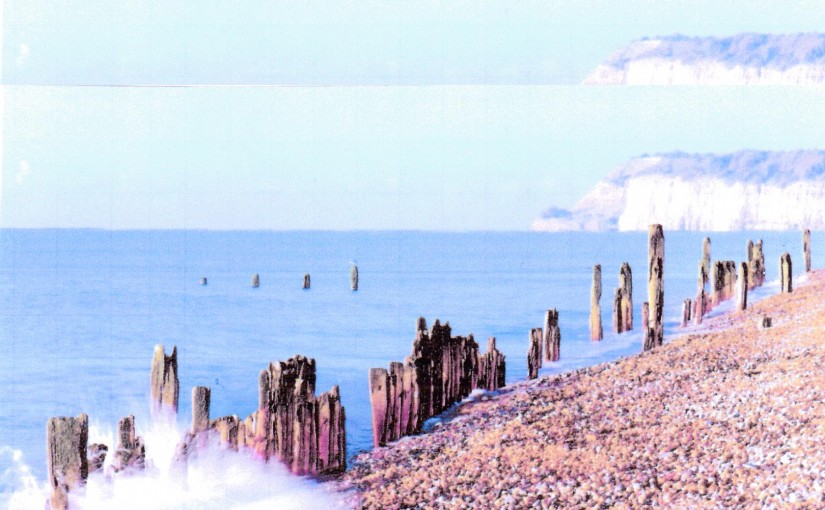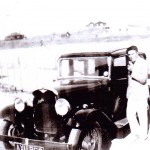Barry Floyd
Like many families in London after World War I — and with a gradual return to a more normal way of life — my newly-married parents (father had served with the Royal Electrical Engineers in France from 1915 to 1919) began looking from their semi-detached Edwardian home in Palmers Green (North London) at favourable seaside spots where a brief summer holiday might be undertaken. Apparently, during the 1920’s, they looked at sites such as Jaywick Sands, near Clacton-on-Sea, Margate, Broadstairs and Cliftonville in Kent without being over impressed, although I believe they did take a few holidays in S.E. Kent, without committing themselves to a more permanent base. I have a picture of my older brother Darrell at Cliftonville while the earliest picture of me, at the age of one, shows a well-wrapped babe squatting on the sands at Broadstairs:
Sometime later Dad had a word with a Mr. Westoby real estate agent in Winchmore Hill where my grand-parents lived. He owned a summer hut on a small hill at the very end of Sea Road (now Dogs Hill Road) at Winchelsea Beach, facing the sea and with impressive views of Rye Bay extending all the way from the cliffs at Fairlight to the lighthouse at the end of Dungeness Promontory. A short distance seawards from Mr. Westoby’s hut were some old coastguard cottages which, while no longer serving the purpose for which they were erected, were now available for rent at very reasonable rates.

It may have been quite a lengthy journey by a small car in those days, across London and via the Blackwall Tunnel to Kent and East Sussex, taking at least 2 1/2 to 3 hours, but my parents were sufficiently satisfied that the Beach would provide a relaxing holiday –with plenty of sea bathing — that they eventually put their names down for a rented coastguard cottage in 1929: not an auspicious year with regard to global finance.
My earliest firm recollection of staying there is from 1930, when I was five years old. This picture shows me sitting on the stone wall at the front of the coastguard cottages, together with my little sister Valerie, aged two. ‘Nanny’ (our grandma) is poking her head out of the front door just as Daddy was taking the picture. Another picture shows my sister and I are sitting on the shingle beach with the tide out.
Needless to say, we children loved staying at the Beach and greatly looked forward to our annual visit to the seaside. At high tide, when the waves lapped the boundary wall of the cottages, we were invariably in the water — regardless of the weather — supported by inflated inner tubes which were later abandoned when we discovered that we could actually swim! When the tide went all the way out, then we could go shrimping, search among rocks for baby crabs which Valerie would wrap in seaweed to create a ‘hospital’, build sand-dams to create sizeable reservoirs of run-off water draining from the beach (breaching the dam as the sea returned meant a pleasing if temporary respite to the advance) and searching for ‘precious stones’: sea-polished pieces of broken glass — white, green and rarer blue.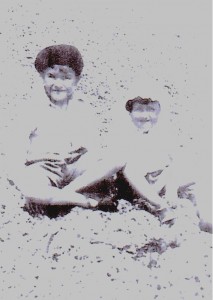
Then came the day when, in 1931, an extra high tide occurred. It was on a Sunday morning when we were still in residence and quite memorable for, as we sat down to dinner, so the sea came seeping into the living room and, splashing and padding, we tucked our way into our Sunday roast! I do not recall any further such episode but evidently, after we had returned to Palmers Green, some quite severe storms and high tides must have taken place later that year, resulting in fatal damage to the coastguard cottages which were ultimately demolished. A famous old Ship Inn, further along the coast towards Pett Level, was also a victim of the same marine encroachment.
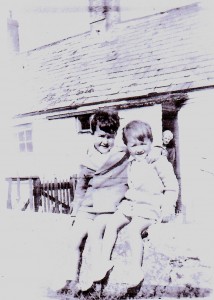
What were we to do? Our beloved holiday home — the Coastguard Cottages –had been destroyed in 1931 and yet we still loved Winchelsea Beach and all that it offered to us as children: tide in or out. Fortunately, our parents had also developed an affection for the area and so, after a break of a year or two, Dad decided we would have a bungalow of our own and ‘Happy Landing’ was built on a ridge of higher land on the west side of Sea Road, just 100 yards or so from the shore. Mr. Westoby also decided to construct a bungalow next to ours; his little beach hut had also suffered from the storms and the site is today occupied by public toilets.
The ridge on which our summer homes were built represents the remains of dredged material from the creation of the so-called Smeaton’s Harbour, an eighteenth century project to provide a new route for vessels to reach Rye via the Brede, since the River Rother was proving erratic in its course and navigability. It is unfair and misleading to name the abortive venture after Smeaton (better known for his construction of the Eddystone Lighthouse) since he was only brought in as a consultant when things were going badly wrong, some 39 years after the work had started. There was little, in fact, that Smeaton could recommend. The planners had failed to allow for changing sea levels and sizeable movement of shingle eastwards from the cliffs at Fairlight. There were continued problems in keeping the harbour mouth free and the new waterway was open for just a few years before being abandoned in 1787, some 60 years after the start of excavations.
There is now little to be seen of Smeaton’s Harbour, largely because the remains have been covered by new deposits of shingle purposely added in defence of the current, post-war constructed sea wall (Dutch consultants). The large white stone blocks which formed the eastern pier are rarely viewed today. However, further out to sea and at low tide, the two pier heads or harbour arms may still be seen, with rock rubble a favoured home for crabs: little and big.
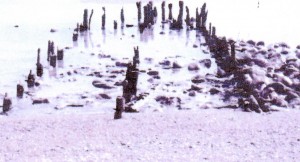
The nice long field at the Beach, now in use recreationally, is a nostalgic reminder of the ambitious but ultimately disastrous failure of the whole venture. Of course, as small children, we had no knowledge of the history behind the field, but instead spent many happy hours there when not swimming, shaping cut hay to form little shops from which we sold empty cigarette packets and other items, exchanging goods with other traders using bottle top ‘coins.’
The picture on the left at the top of page five shows the three Floyd children standing within an inner tube outside the front porch of ‘Happy Landing.’ On the right the trusty old Austin car which brought us from London to the Beach, loaded with provisions, the children, Nanny and our Airedale dog! Beyond the car may be seen part of the field, today’s reminder of the former harbour project. On occasion, in the early 1930’s, the sea still penetrated into the field and I can recall one year watching a few field mice struggling to reach higher ground.
With our own second home, the summer holidays could now extend to a welcome six weeks and we even made weekend visits every so often following Easter. It was to remain this way right up to the outbreak of WWII in 1939 and I could not have had a happier childhood in such a pleasing location.
Meanwhile, during the 1930’s, sea defences had become a matter of priority at the Beach and along other sections of Rye Bay. This led to the construction of a stout wooden wall, with a parallel wave screen and breakwaters set at right angles to the drift of shingle from the west. There had been a few faggot brushwood obstacles in earlier years but these had proved ineffectual when the storm waters raged. This picture shows me with my brother and sister — our backs to the new sea wall, — having just enjoyed another swim. Some years later I am seen perched on the wave screen with the tide in.
The remains of the screen are seen in a contemporary colou picture of the Beach, with the cliffs at Fairlight in the background.
At the end of the road, just before the sea wall, there appeared a small white kiosk which sold ice creams, sweets, cigarettes (for my brother to experiment with) and soft drinks, whose discarded bottle tops were to serve as our currency in games later played in the field. Then, on the other side of the field, was another confectionary shop so we children were well supplied with places to spend our pocket money. We favoured the Walls, blue-checked triangular ice sticks over the Eldorado ice creams. Later, a larger green hut was constructed, partly on the wall itself. This served refreshments and sweets and I was able to assist on some days while playing with the twin children of the owners. What more could a child ask for?
Then, on a Sunday morning early in September 1939 and while still at ‘Happy Landing’, we all heard the solemn news that Britain was at war with Germany. As if to emphasize the event, soon after 1100 am, the air raid sirens sounded in distant Rye. I had recently turned 14, but the full impact of the impending war was not appreciated – perhaps it meant only a possible reorganization of my toy soldier collection back in London.
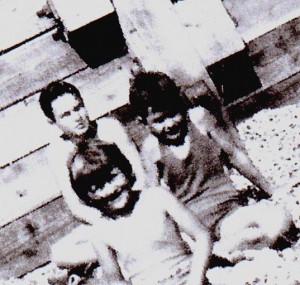
Our parents had taken heed of possible early German aerial attacks on the capital and learned also of the planned mass evacuation of children from London to more rural areas to the south and west. It was decided that my sister Valerie and I would remain at Winchelsea Beach but not in our summer home. Instead, after our parents had returned to London for Dad’s job, we would — as evacuees – stay with an elderly couple who lived in ‘Little Grey Home’, near Pellett’s Store, a little way inland but still a part of Winchelsea Beach. Mr and Mrs Easton were very kind to us and tried to make us as comfortable as possible, although we were inevitably homesick and no doubt wrote letters to Mum pleading that we should return home to Southgate, North London. Memories of the Eastons involve bird watching in the back garden and attempting water colour versions, a weekly bath in a tin tub in the kitchen, and observing Mr. Easton’s glass eye which he removed each night to place in water!
We were accepted as students at Rye Grammar School, later to become the Thomas Peacocke School, and attended classes each day by travelling on the red East Kent buses which linked Winchelsea Beach with the nearby town. We now began to see more of Rye than in prewar days, going to the Regent Cinema at weekends. My parents drove down to see us at Christmas, when Happy Landing was again briefly occupied, but did not make more regular visits which would only have stoked our home sickness.
Early in the New Year, 1940, the weather turned severe and there was a lot of snow. So much, in fact, that quite high drifts blocked the Sea Road and the East Kent buses were unable to get through. Naturally we kids enjoyed playing in the snow and had no regrets at missing classes! Come, eventually, the Spring and Valerie and I ventured on our bicycles on little excursions into the surrounding countryside. The bluebells and primroses were particularly lovely. We also resumed fishing in the nearby dykes, where at times we had been when younger, there to catch an occasional perch, bream or, less desirably, a small eel. We had to keep an eye out for frisky bullocks in the adjacent fields.
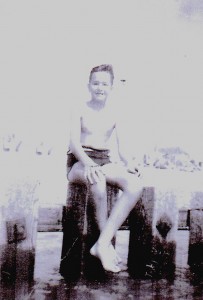
By Easter time the anticipated Luftwaffe attacks on the capital had failed to materialize and many of the child evacuees were heading back to London to rejoin their families. By his time too, our pleadings were finally acknowledged by our parents and we were able to bid a fond farewell to the Eastons and to drive happily home to Southgate. It was great to be back in one’s own little bed and in familiar surroundings. However this peace was to be short-lived. Soon the skies above were filled with the contrails of fighter aircraft – Hurricanes, Spitfires and Messerschmitt 109s. Now the air raid sirens wailed frequently and in earnest as the Battle of Britain waged. A few months later, night-raiding Heinkel lII and Dornier D017 bombers were over London and we children had returned to experience the full force of the ‘Blitz’ I
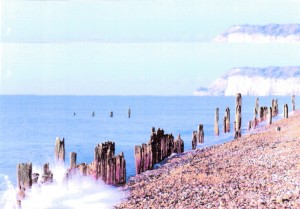
“Rye’s Own” March 2015
All articles, photographs and drawings on this web site are World Copyright Protected. No reproduction for publication without prior arrangement.
